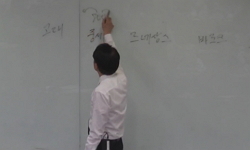19세기 폴란드 출신의 작곡가 쇼팽은 자신만의 독보적인 아름다운 선율로 사람들의 감수성을 자극해 남녀노소를 불문하고 가장 사랑받는 피아노 음악가로 손꼽힌다. 쇼팽이 활동했던 19세기...
http://chineseinput.net/에서 pinyin(병음)방식으로 중국어를 변환할 수 있습니다.
변환된 중국어를 복사하여 사용하시면 됩니다.
- 中文 을 입력하시려면 zhongwen을 입력하시고 space를누르시면됩니다.
- 北京 을 입력하시려면 beijing을 입력하시고 space를 누르시면 됩니다.
Frederic Chopin의 Piano Sonata No. 3 in b minor, Op. 58의 분석 연구 = A Study on an Analysis of Frederic Chopin's Piano Sonata No. 3 in b minor, Op. 58
한글로보기부가정보
국문 초록 (Abstract)
19세기 폴란드 출신의 작곡가 쇼팽은 자신만의 독보적인 아름다운 선율로 사람들의 감수성을 자극해 남녀노소를 불문하고 가장 사랑받는 피아노 음악가로 손꼽힌다. 쇼팽이 활동했던 19세기는 산업 혁명의 영향으로 피아노의 발달과 클래식 음악의 대중화가 일어났던 시기이며, 이 시기에는 새로운 음악에 대한 수요 증가로 많은 피아노곡들이 작곡되고 출판되었다.
이러한 시대적 흐름에 따라 자신의 모든 재능을 피아노 음악에 쏟아부은 쇼팽은 왈츠, 마주르카, 폴로네이즈, 스케르초, 녹턴 등 다양한 성격소품들을 작곡하였다. 쇼팽은 수많은 피아노 작품 중 3개의 소나타를 남기고 있는데, 본 논문에서는 그의 원숙미가 돋보이는 대규모의 마지막 소나타인 <Piano Sonata No.3 in b minor, Op.58>을 살펴본다.
이 작품은 1844년 쇼팽의 예술적 영감과 음악 어법이 절정에 달했던 시기에 작곡되어 그의 선율, 리듬, 화성, 형식, 템포 루바토, 페달적인 특징들을 모두 담고 있다. 쇼팽은 이 소나타에서 독창적인 음악어법을 드러나게 하기 위하여 외형적으로 전통적 소나타 형식의 구조를 따르면서도 악장의 템포 구성과 주제의 재현 순서를 바꾸는 등 형식의 틀에 얽매이지 않는 구성을 보인다. 또한 여러 종류의 변화화음과 불협화음을 포함한 혁신적인 화성과 자유로운 비화성음의 사용, 반음계적 진행을 통한 전조와 이명동음을 이용한 전조 사용 등을 통해 전조의 무한한 가능성을 보여준다.
본 논문에서는 소나타 3번의 심도 있는 분석을 통해 연주자로 하여금 쇼팽의 음악적 특징과 다양한 음악적 기법들을 깊이 이해하고, 작곡가의 의도대로 낭만적인 정서를 충실히 표현할 수 있도록 한다.
다국어 초록 (Multilingual Abstract)
Frédéric Chopin (1810–1849), a Polish composer wrote primarily for solo piano and has maintained worldwide renown by touching audiences’ emotion with his poetic melody. The nineteenth century when Chopin was active in his career saw the Industri...
Frédéric Chopin (1810–1849), a Polish composer wrote primarily for solo piano and has maintained worldwide renown by touching audiences’ emotion with his poetic melody. The nineteenth century when Chopin was active in his career saw the Industrial Revolution, which in turn classical music was popularized and piano physical went through innovations such as the cast iron frame and aliquot stringing gave grand pianos a more powerful sound. As a result, the demand for piano music increased, and many composers at the time wrote and published a lot of piano music.
Chopin dedicated his time to write piano music and left various character pieces such as Waltzes, Mazurkas, Polonaises, Scherzos, Nocturnes. Especially, Chopin wrote three piano sonatas. This dissertation will take a close look at his Piano Sonata No. 3 in b minor, Op. 58 which is the last sonata on a large scale among his piano sonatas.
Chopin’s b minor Sonata was written in 1844 when Chopin has a mature compositional language, so it comprised his unique melodies, rhythms, harmonies, forms, tempos, rubatos, pedal technics. He exploited a traditional sonata form but at the same time, he changed a formal tempo model and recapitulated a subject in a different way to deviate the tradition, which reflected Chopin’s noble musical language. In addition, this work was cast in innovative harmonies including borrowed chords and dissonances, freer use of non-chord tones, and chromatic modulations/ enharmonic modulations with the unlimited possibility of modulations.
Through the intensive study of Chopin’s Sonata in b minor, this dissertation will contribute to a performer’s understanding of Chopin’s musical characteristics and various musical techniques and to a performer’s expression of romantic emotions as the composer’s intention.
목차 (Table of Contents)
- 목 차
- Ⅰ. 서론 1
- 1. 연구의 목적 및 필요성 1
- 목 차
- Ⅰ. 서론 1
- 1. 연구의 목적 및 필요성 1
- 2. 연구의 방법 및 제한점 2
- Ⅱ. 본론 3
- 1. 낭만주의 음악 3
- 1) 낭만주의 음악의 시대적 배경 3
- 2) 낭만주의 피아노의 발달 4
- 2. F. Chopin의 생애 6
- 3. F. Chopin 피아노 음악의 특징 10
- 1) 선율 11
- 2) 리듬 13
- 3) 화성 14
- 4) 형식 15
- 5) 템포 루바토 15
- 6) 페달 16
- 4. F. Chopin Sonata No. 3 in b minor, Op. 58의 분석 18
- 1) 작품 배경 및 구성 18
- 2) 악장별 연구 및 분석 19
- (1) 제 1악장 Allegro maestoso 19
- (2) 제 2악장 Scherzo : Molto Vivace 34
- (3) 제 3악장 Largo 39
- (4) 제 4악장 Finale : Presto, non tanto 48
- Ⅲ. 결론 60
- 참고문헌 61
- Abstract & Keywords 62












